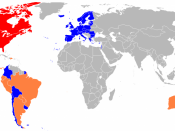As globalization becomes the main stream of the world, countries have more tight relationship between each other both in politics and economy. To achieve this, regional economic integration has the leading effect. Free Trade Area (FTA) is perceived as the fundamental level of economic integration and also the most popular form, where all the government interferences and regulations on trade of goods and services among member countries are removed e.g. it reduces or ceases the tariff and nontariff barriers in the region. Meanwhile, the members can set their own trade policies to the countries outside the FTA. (Hill, 2007) In the first section of this essay, the advantages and disadvantages of FTA to the member countries and the rest of the world will be discussed. Furthermore, there is another discussion about the gains and loses of Chinese industries based on the ongoing formation of FTA among China, Korea and Japan.
After the analysis in section 2, the reasons for recommending China to support the establishment of this FTA will be listed.
To form a FTA, a series of negotiation will be made among members to concede to open up their markets. Thus, FTA is considered as a driver of trade liberalization. (the Australian APEC study centre, 2001) With better access to the each other's market, FDI as one of the important impacts come along with trade liberalization can be seen as the advantages of FTA. After forming FTA, it is more attractive for FDI from both inside and outside of the FTA. The establishment of FTA could involve both developing and developed countries. In a developing country, there is lower labor cost and cheaper factors of production, besides, owing to the less restriction of capital flow among member countries within the FTA, multi-national enterprises have more willingness to invest "internally".



QuestionTitle
QuestionTitle:
Discuss the advantages and disadvantages, to the participating countries and the rest of the world, of forming a free trade arrangement. China, Japan and Korea are now undertaking preliminary research into the formation of a free trade area. Within China, which industries might gain and which might lose from such an arrangement. Would you recommend that China give its support to the establishment of this area?
2 out of 2 people found this comment useful.